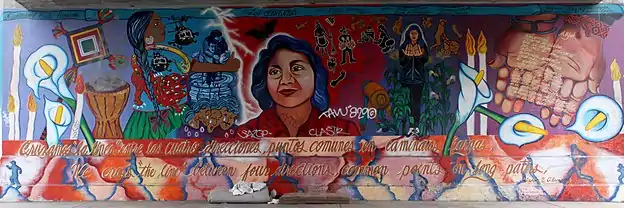Yreina Cervantez
Yreina Cervantez (born 1952) is an American artist and Chicana activist who is known for her multimedia painting,[1] murals, and printmaking. She has exhibited nationally and internationally,[2] and her work is in the permanent collections of the Smithsonian American Art Museum,[3] The Mexican Museum,[4] the Los Angeles County Museum, and the Los Angeles Museum of Contemporary Art.[5]
Yreina Cervantez | |
|---|---|
| Born | 1952 (age 68–69) |
| Education | University of California, Santa Cruz, University of California, Los Angeles |
Notable work | La Ofrenda |
Biography
Cervantez was born in Garden City, Kansas[5] and raised in Mount Palomar, California.[6] Cervantez's mother was creative and served as an artistic inspiration to her daughter.[7] Her childhood was spent in culturally segregated, rural areas and exposure to the conservative attitude of these neighborhoods inspired Cervantez to later join the Chicana/o movement.[7] Later her family moved to Orange County.[7]
During high school, she focused on her watercolor skills.[7] Cervantez received a BA from the University of California, Santa Cruz and in 1989 graduated from the University of California, Los Angeles with an MFA.[6] A founding member of the Los Angeles art collective Self Help Graphics, Cervantez spent six years working for this non-profit dedicated to supporting community artwork.[5][7] In 1987, Cervantez's work was shown in Chicago at the Mexican Fine Arts Center Museum.[8] Her work was also part of the CARA project and traveling exhibition which opened in 1983 and had its final venue in 1994.[9] Cervantez was a cast member of the feminist film, Define (1988), by O.Funmilayo Makarah.[10] Between 1990 and 1993, she worked as a coordinator at the Los Angeles Municipal Art Gallery.[5] Cervantez is currently a professor of Chicano Studies at California State University, Northridge.[5]
Art

Cervantez's work often includes a rich visual vocabulary that draws inspiration from pre-Columbian history, Central American politics, the urban landscape of Los Angeles and sometimes herself, as a viewer of what she is painting.[11] She overlaps two different "worlds," one of the present and another of the past, creating a visual space where ideologies are explored and examined.[11] She uses the visual language of Aztlan to create a new artistic vocabulary.[12]
Growing up, Cervantez did not see many Latina images in popular culture and because of this, her portraits of Latina women and her self-portraits became an important part of her work.[13] Cervantez's self-portraits show an artist that is at once whole and fragmented, experiencing nepantla.[11] Cervantes often uses the self-portrait technique in order to explore cultural identity.[14] In many of her self-portraits, she continues to blend contemporary culture with Aztec and mesoamerican imagery.[6] Cervantez uses much of this type of iconography of the past in order to update the symbols and create a modern feminist perspective.[15] Her female figures are often described as "inspiring representations of female agency."[12] Cervantez's art is also concerned with helping the viewer recognize that Chicanos are already in their own "ancestral homelands" and are actually not "immigrants" to the United States.[1]
Cervantez has also created many large-scale murals in Los Angeles[16] and is considered a pioneer of the Chicana mural movement.[6] She was involved with designing and painting part of The Great Wall of Los Angeles, which is thought to be the longest mural in the world.[17] Cervantez has been a major influence on artist Favianna Rodriguez, who was so impressed with a printmaking class she took with Cervantez that she quit school to become a full-time artist.[18]
References
- Pérez, Laura E. (9 August 2007). "Legacies of Im/migration: Yreina Cervantez's Tierra Firme and La Ruta Turquesa". Chicana Art: The Politics of Spiritual and Aesthetic Altarities. Duke University Press Books. ISBN 978-0822338680.
- "Guest Artists". Public Art in LA. Retrieved 27 March 2015.
- "Estrella of the Dawn, from the National Chicano Screenprint Taller, 1988–1989". Smithsonian American Art Museum. Retrieved 18 March 2015.
- "The Mexican Museum Introduces Additions to Its Arts & Letters Council". Yahoo! Finance. 2 August 2013. Retrieved 26 March 2015.
- Barraza, Santa (4 September 2012). "Exhibit Features Work by Chicana Artist Yreina Cervantez". Texas A&M University-Kingsville. Retrieved 26 March 2015.
- Freese, Lauren M. (2013). "Frida Kahlo and Chicana Self-Portraiture: Maya Gonzalez, Yreina D. Cervantez, and Cecilia Alvarez". Iowa Research Online. University of Iowa. Retrieved 18 March 2015.
- Ho, Christopher (7 November 2011). "CSUN Professor Paints her Way Through Male-Dominated Art Industry". The Sundial. Retrieved 18 March 2015.
- Quirarte, Jacinto (1991). "Exhibitions of Chicano Art: 1965 to the Present". In Castillo, Richard Griswold Del; McKenna, Teresa; Yarbro-Bejarano, Yvonne (eds.). Chicano Art: Resistance and Affirmation, 1965–1985. Los Angeles: Wight Art Gallery. p. 174. ISBN 0943739152.
- "Companeros and Partners: The CARA Project". Americans for the Arts. Retrieved 27 March 2015.
- McMahon, Kevin. "Define". UCLA Film & Television Archive. Retrieved 26 March 2015.
- Barnet-Sánchez, Holly (2001). "Where are the Chicana Printmakers?". Just Another Poster? Chicano Graphic Arts in California (in English and Spanish). Santa Barbara, California: University Art Museum, University of California. pp. 117–149. Retrieved 18 March 2015.
- Braysmith, Hilary A. (13 September 2013). "Constructing Athletic Agents in the Chicano/a Culture of Los Angeles". In Wood, David; Johnson, P. Louise (eds.). Sporting Cultures: Hispanic Perspectives on Sport, Text and the Body. Routledge. p. 45. ISBN 9781317991328.
- Garcia, B (11 April 2011). "Events: 'Selected Works in Paper' by Yreina D. Cervantez". The Monitor. Retrieved 26 March 2015.
- Keller, Gary D. (2004). Chicano Art for Our Millennium. Tempe, Arizona: Bilingual Press. p. 86. ISBN 1931010250.
- McCaughan, Edward J. (28 March 2012). Art and Social Movements: Cultural Politics in Mexico and Aztlan. Duke University Press Books. p. 132. ISBN 978-0822351825.
- Goldman, Shifra M. (1994). Dimensions of the Americas: Art and Social Change in Latin America and the. ISBN 9780226301242.
- Tannenbaum, Barbara (26 May 2002). "Where Miles of Murals Preach a People's Gospel". The New York Times. Retrieved 26 March 2015.
- "Favianna and the New Print Revolution". East Bay Express. 1 July 2009. Retrieved 26 March 2015.